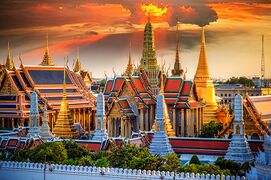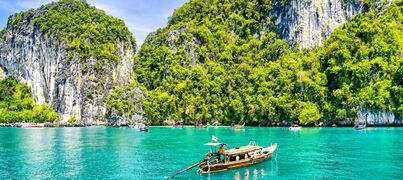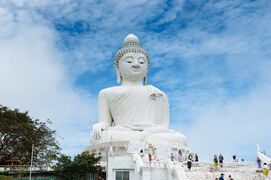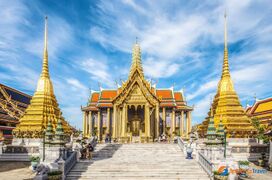Thervala
Thervala ("The Kingdom of Thervala") Ratcha-anachak Ther (Ther) | |
|---|---|
|
Flag | |
Motto: ชัยชนะด้วยเลือด ("Victory through blood") | |
Anthem: | |
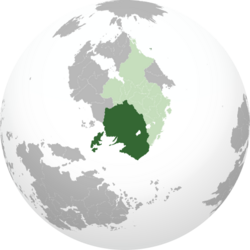 Location of XXX (dark green) In XXX (gray) | |
| Capital and largest city | Wat Kram |
| Official languages | Ther |
| Demonym(s) | Ther (noun) Theran (adjective) |
| Government | Constitutional Monarchy |
• King | Ananda Varma II |
• Prime Minister | Chatchai Suriyawan |
| Legislature | National Assembly |
| Senate | |
| House of Representatives | |
| Establishment | |
• An event | A date |
| Population | |
• Estimate | 80,000,000 |
| GDP (PPP) | estimate |
• Total | 7,800 |
| GDP (nominal) | estimate |
• Total | Your GDP = GDPPC x Population (This is calculated for you after first entry) |
• Per capita | Your GDP PC |
| Gini | Your gini coefficient Error: Invalid Gini value |
| Currency | Rathan (RTH) |
| Driving side | right |
Thervala, officially the Kingdom of Thervala, is a constitutional monarchy in Audonia. It is neighbored by Oyashima, XXX, and XXX
Although the modern state that is the Kingdom of Thervala has only existed for a few centuries, people have been living in that region of Audonia since prehistoric times. The borders of the Kingdom of Thervala have also remained consistent since the forming of the original Vishran Dynasties. For a majority of its history, the kingdoms that have existed in the region that is now known as Thervala have either been ruled by foreign dynasties or vassalized under stronger foreign powers.
The earliest recorded state in the region was a Peshabi dynasty of nobles from the Arunid Empire known as the Vishran Dynasty that came to the Thervalan region of Audonia in 200 BCE. The Vishran Dynasty introduced written language and civilization to the indigenous Ther population and much of ancient Ther culture is also linked to the Vishran Dynasty and this process is academically known as Arunidisation. The Vishran dynasty came to its eventual end due to the conquests of the Myanga Ayil Khanate. The capitulation of the Vishran Kingdom was largely bloodless, except for the Arunid ruling class. In the centuries that came after the formation of the initial kingdom, the Arunid ruling class became infamous for its hedonism and brutal style of ruling.
Because the indigenous ethnic Ther were collaborative with the Great Khan, an ethnic Ther dynasty was installed as a vassal under the Khanate in 1300 CE. This dynasty was known as the Khram dynasty, and is responsible for the founding of the Kingdom's capital city, Wat Khram. The Khram dynasty also issued edicts in regards to the development of the kingdom's civil and legislative codes, as well as making the state religion Theravada Buddhism. Modern Thervala can also trace its martial culture to the Khram dynasty, as part of the vassalization required the Khram Dynasty to provide the Khanate with a steady supply of well trained and well supplied troops to assist in the Khanate's conquest of Audonia.
The Khram dynasaty were loyal to the Khanate for centuries, largely due to the protection that was provided as well as the Khanate's laissez faire policy towards Ther self determination and national identity. As conquests started to take a toll on the Ther population, a sentiment for independence began to develop. It wasn't until 1650 that the Khram dynasty came into contact with Burgundie and the Ularien Trading Company (UTC). Upon establishment of Diplomatic missions, the Khram dynasty was more than willing to act as a collaborative force against the now hated Khanate.
Thervala is a member of the League of Nations.
Etymology
The Ther people are the indigenous ethnic group of Thervala, and in the Ther language “Ther” directly translate to “Person” or “People”. “Vala” in Ther is an honorific title meant to denote a holiness or purity. Thervala is then representative not only of the borders of the country itself, but also its people. The Land of the (Holy People).
History
What is a general overview of your country's path through history?
First era
In prehistory, Thervala was comprised of small, religious tribes that lived in fishing communities in and around the East Audonian wetlands. A majority of what is known from this time period comes from bog bodies found in and around swamps near major pre-historic settlements. It is heavily theorized that these bog bodies are instances of ritual sacrifice.
Second era
Ancient Thervala's history is predominantly that of the Vishran dynasties. These dynasties were kingdoms ruled by families originating from the Arunid Empire. This period is significant for introducing a written system, marking the earliest recorded history of Thervala.
The Peshabi princes, originally from Peshab, were dispossessed of their lands by the Pukhti royal family. The Pukhti sought to consolidate power and distributed these lands to their growing network of royal sycophants. Forced to seek new opportunities, the Peshabi princes traveled north, following the end of the trade routes, until they encountered the tribes of the Ther people. Demonstrating remarkable leadership and strategic acumen, the Peshabi princes united the Ther tribes under the banner of the Vishran dynasty, establishing a new era of governance and cultural development in Thervala.
Third era
What were your country's first major moves on an international level?
Fourth era
Did your country ever have a period of significant decline or internal struggle?
Fifth era
Was your country subject to imperialism later in its life, or was it an imperial power?
Sixth era
How did the 20th century affect your country?
Geography
What is the general explanation of how your country exists within the world?
Climate and environment
Is your country hot or cold?
Government and Politics
How is your country ruled or governed?
Executive
Who is responsible for making high level choices in your country? Does it have a President or King?
Legislative
Who decides the laws for your country? Is there political parties and a legislature?
Federal subdivisions
How is your country divided? Are there states or provinces, or is the country directly governed from the capital as a unitary state?
Politics
What political factions exist? Who has ruled predominantly?
Law
What kind of laws and legal system does your country employ?
Demographics
What kind of people live in your country?
Ethnicity
What ethnic groups make up your country?
Language
What language or languages do your country's people use? Are there any previously used languages no longer common? Are these languages native to your country or shared with another?
Religion
Religious affiliations in the XXX (20XX)
What do your country's people believe in religiously, if anything? How many groups are there?
Education
How many people in your country are educated?
Culture and Society
What do your people do, and what are they like?
Education
What is your country's education system like? How do the schools work? What do people think about education?
Attitudes and worldview
How do your country's people view life?
Kinship and family
How are families or kinship groups structured in your country?
Cuisine
What do your people eat?
Religion
What do your people believe? Rather than demographics, as above, think about how important religion is to your people and their view about their own and other religions. What is the relationship between the prevailing view and minority religious groups? Is it an official religion, and do any laws exist about free worship?
Arts and Literature
What type of art do your people make? Do they have a tradition of painted art, well-crafted television shows, or great music?
Sports
Does your country have any major sports leagues? What types of sports are played, both professionally and for fun by your country's people?"
Symbols
Are there any prominent symbols which are well known to represent your country?
Economy and Infrastructure
How does your country's economy work?
Industries and Sectors
What are the largest parts of your economy in terms of what they do?
Currency
What exchange systems are used within your country's economy?
Healthcare
How do people in your country procure medical care? How is it paid for?
Labor
How is labor organized within your country? Are there any social institutions or unions which deal with labor concerns?
Transportation
How do people in your country get around? Is there a major highway system as well as sea- and airports?
Energy
What type of energy keeps your nation going? Are you renewable or use fossil fuels, and if you are renewable, how recently did your country transition?
Technology
How advanced is your country? Is it an innovator, or does it largely import new developments?
Military
How large is your country's military? Is it large but poorly equipped or small and elite? Does your country have a martial tradition?

